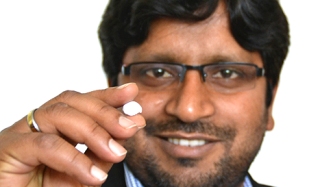Jun 8 2015
Scientists at Kiel University have utilized simple, highly efficient flame technology to synthesize nanoscale materials from tin oxide.
 Yogendra Kumar Mishra presents the stretchable ceramic made from tin oxide. Photo/Copyright: Claudia Eulitz, CAU
Yogendra Kumar Mishra presents the stretchable ceramic made from tin oxide. Photo/Copyright: Claudia Eulitz, CAU
Researchers have been able to successfully bake nanostructures using zinc oxide. This study focuses on tin oxide, which holds significant promise for a wide range of potential new applications.
Nanoscale materials have so far been synthesized in high-tech laboratories, where scientists try to keep even fine dust away from their research materials, by wearing full-body suits.
Metal oxides in bulk form cannot be used for a wide range of applications as they are usually brittle. However, 1D structures of these materials possess a high surface to volume ratio, due to which they could possibly be used for many applications. Belt-like nanostructures are considered to be 1D structures. The high surface to volume ratio provides astounding physical and chemical properties, and a high degree of bendability.
“However, 1D nanostructures are still difficult to use, because integrating them in real devices is a challenging task. To overcome this issue, we have developed three-dimensional (3D) macroscopic material from 1D tin oxide belt-like nanostructures. The resulting ceramic networks exhibit most of the nanoscale properties, including flexibility. It can therefore be freely utilized for any desired application. We are very pleased that our recently introduced flame transport synthesis method on the basis of zinc oxide now enables the simple synthesis of interconnected 3D networks from tin oxide”, says Dr Yogendra Kumar Mishra, group leader of the working group “Functional Nanomaterials” at Kiel University, and main author of the study.
“The fascinating part is the structure of the single belt-like nanostructures delivered by this synthesis on the basis of tin oxide crystal structure. In contrast to ceramic produced with zinc oxide, which leads to very short tetrapod structures, tin oxide gives long, flat structures. They are just like fettucine”, compares Professor Rainer Adelung, Chairperson of the Functional Nanomaterials group. “And these long flat noodles grow together in a very specific way: In the oven used for the synthesis, temperatures stay just below the melting point of tin oxide. Thus, the noodles find specific interconnection points by kinetics instead of thermodynamics. Each junction is forced into a well-defined angle following strict geometric principles, which are based on so-called twinning defects, as further confirmed by simulation studies”, adds Professor Lorenz Kienle, Chairperson of the Synthesis and Real Structure group.
The research team utilized transmission electron microscopy to analyze the grown-together noodles, which was the tin oxide 3D network’s structural design.
“The 3D networks from tin oxide exhibit interesting features, such as electrically conducting, high temperature stable, very soft and stretchable architecture, and could thus be interesting for several technological applications”, says Dr Mishra.
The researchers have fabricated a portable electronic sensing device, which holds significant promise for gas sensing or UV light applications.
“Until now, we have tested sensing applications. Further potential applications could also be flexible and stretchable electronic devices, luminescent actuators, batteries, smart cloths or sacrificial templates for the growth of new materials.” Professor Ion Tiginyanu from the Technical University of Moldova and his team has collaborated in this study.
The three Kiel scientists state: “Development of such 3D network materials from tin oxide, with geometry determining defects made by flame transport synthesis at Kiel University is a very interesting step forward into the future of nanostructure growth and applications.”
The findings of this study titled, “Three dimensional SnO2 nanowire networks for multifunctional applications: From high temperature stretchable ceramics to ultraresponsive sensors,” has been published in the journal Advanced Electronic Materials.